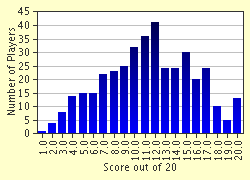Quiz Answer Key and Fun Facts
1. It may not be a literary work in the strict sense of the word, but what is generally regarded as the first piece of writing in French?
2. Which celebrated medieval poem is the work of the Norman poet Béroul?
3. Born in Paris in 1431, he became a Master of Arts of the university. He was pardoned for the manslaughter of a cleric in 1455, and left Paris in 1456 after being involved in a robbery. Returning to the city about 1462, after various scrapes in the provinces, he was soon in trouble again, and was sentenced to death in 1463 for involvement in the killing of a notary. He was reprieved and exiled, after which we hear no more of him. His most notable poems are the "Lais" and the "Testament". What was his name?
4. In the works of François Rabelais, what is the name of the giant who is the son of Grandgousier and the father of Pantagruel?
5. Generally regarded as the leading poet of the school known as the Pléiade, this man is perhaps best remembered for the poem "À Cassandre", beginning "Mignonne, allons voir si la rose". Who was he?
6. Which of the following plays is not by Pierre Corneille?
7. Jean Racine is celebrated for his tragedies, but he also produced a comedy satirizing the law. What was it called?
8. Which of Molière's plays is an attack on religious hypocrisy?
9. "We are all strong enough to bear the misfortunes of others". "The only thing that should surprise us is that we can still be surprised". "We are never so fortunate nor so unfortunate as we think we are". These are among the 600-odd "Maxims" of which 17th-century writer?
10. What is the title of Voltaire's satire on the philosophy of optimism, i.e. the doctrine that "all is for the best in the best of all possible worlds"?
11. Which of Victor Hugo's plays has a preface which has been described as the manifesto of Romanticism?
12. "Vingt Ans Après" By Alexandre Dumas the Elder is a sequel to which of his other novels?
13. Prosper Mérimée wrote a novella set in Spain which was the inspiration for an opera by Bizet. The novella and the opera have the same title, which is ...?
14. In the title of Stendhal's novel "Le Rouge et le Noir", what do red and black symbolize?
15. Who was the author of "Les Fleurs du Mal", a collection of poems which enjoyed a "succès de scandale" when it was published in the 1850s?
16. Colette's earliest novels, the "Claudine" tetralogy, were written in collaboration with her husband and originally published under his pen-name. What was the pen-name?
17. Which is the first volume in Proust's "roman-fleuve" "À la recherche du temps perdu"?
18. In one of Ionesco's plays the central character, Bérenger, has to defend his humanity in a world in which everyone is turning into a particular species of animal. Which animal?
19. What was the nationality of Georges Simenon, the creator of the Parisian detective Maigret?
20. Which writer was the first woman to be elected to the Académie Française?
Source: Author
TabbyTom
This quiz was reviewed by FunTrivia editor
Bruyere before going online.
Any errors found in FunTrivia content are routinely corrected through our feedback system.

